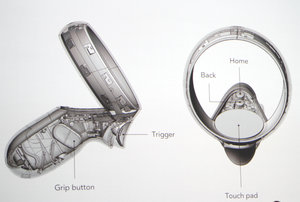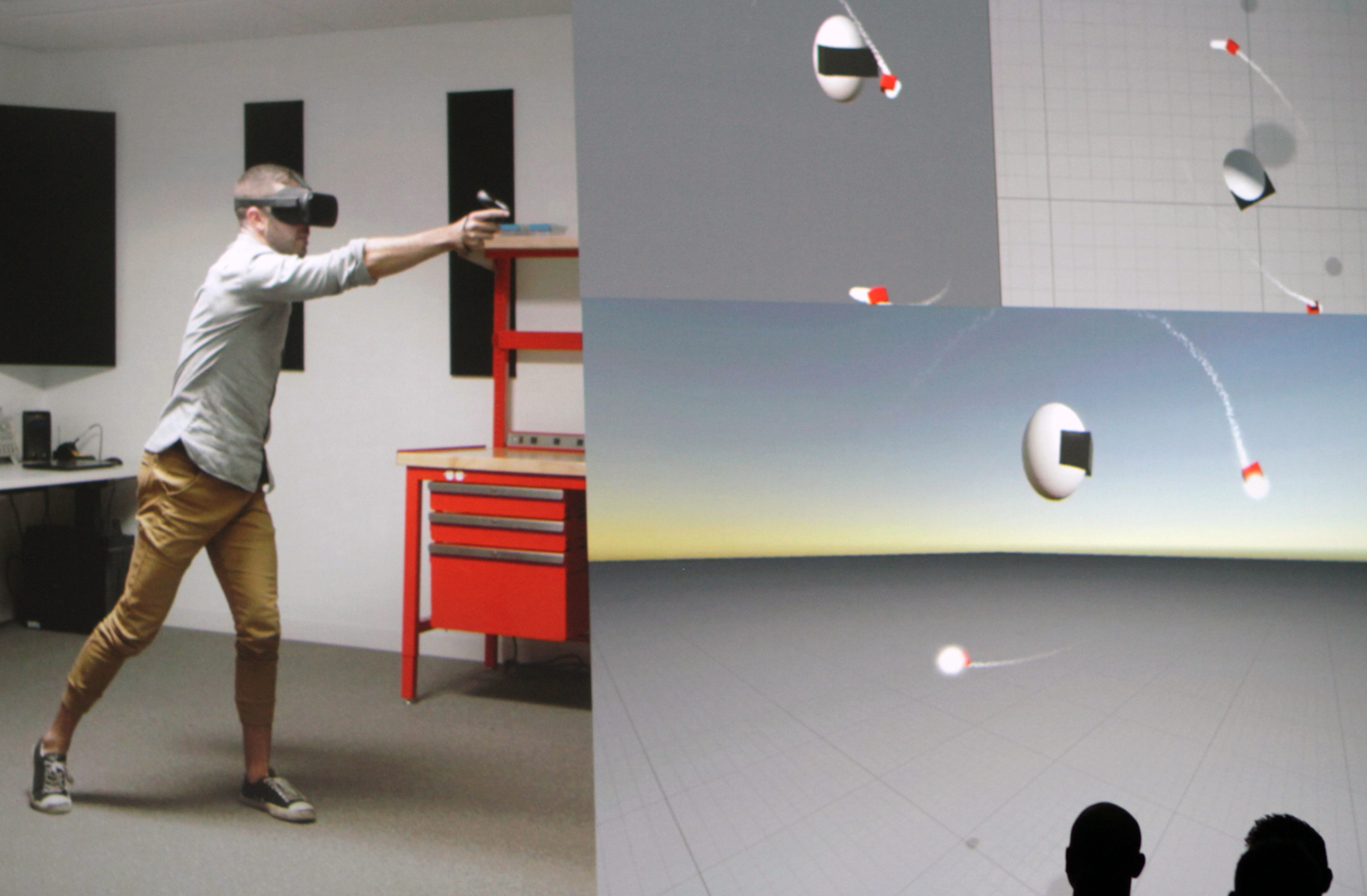Oculus’ Project Santa Cruz, Hands On (Again)


A year ago, we saw a (very) rough prototype of Oculus’ Project Santa Cruz, an untethered standalone HMD, and we’ve now had a chance to spend some time with the latest iteration. The difference could hardly be more stark; the current Project Santa Cruz is still technically a prototype, but it seems like it’s nearly ready for mass consumption.
Unfortunately, the Oculus team was tight-lipped about any details concerning specifications, possible modifications, or even a timeline for when the finished device would ship to developers, so as far as specifications go, we’re still limited to what we’ve been able to extract from the official announcement and other means. We detailed all of that here, including that it runs on a Snapdragon 835 SoC and features inside-out 6DoF tracking.
However, we have some impressions of the headset, the new controllers, and the overall experience.
The Headset
When we first saw the headset, we were surprised at how svelte it looked. (No, we weren't allowed to take any pictures.) Gone was the bulky mess of the earlier prototype; in its place was a compact HMD covered with soft, smooth fabric. We were further taken aback by how light the unit was. It may actually be lighter than a Daydream HMD with a Pixel XL.
Project Santa Cruz has a stretchy but sturdy rubber strap that wraps around the back of your head, and you adjust the tightness with some kind of dial on a strap on top of your head. (We suspect that the rubber strap won’t be part of the final design. For as nicely as it did its job, we wonder how it would hold up after long-term use.) The face cushion is quite soft--as comfortable, or moreso, than any other HMD we’ve donned.
Anecdotally, the optics seemed as crisp and clear as the Rift; we presume that the lenses and display are the same ones found on the flagship headset. We would expect the final Santa Cruz to use a version of the next-gen optics Oculus announced would be on Oculus Go, but those are LCD displays (vs OLED on the Rift), so that's only a guess.
Project Santa Cruz has built-in spatial audio, similar to the HoloLens, which means you don’t need headphones, including the flip-down headphones built into Rift. Some have criticized the HoloLens’ built-in audio for being too quiet, but this headset does not appear to suffer any such limitations, and surprisingly, it didn’t sound small or tinny, either. The audio feature is a strength of Project Santa Cruz.
Get Tom's Hardware's best news and in-depth reviews, straight to your inbox.
The Not-Quite-Touch Controllers
As is our wont, we tried to beat, break, or confuse the Santa Cruz controller tracking, and we were only modestly successful. In short, we found the controller tracking to be lag-free and consistent. We had issues only if we moved our hands too far behind the tracking cameras (which are mounted onto the front and sides of the headset), such as when we were throwing sticks.
The Santa Cruz controllers feel quite similar to the Touch controllers, which is largely because the Touch team is building them. They share a great deal of design language, of course, but there are key differences. One is that the Santa Cruz controllers lack thumb joysticks (an omission at least one developer lamented to us). In their place is a clickable touchpad. You can debate the virtues of joysticks over touchpads, but we found these touchpads to be excellent. The broad surface is glossy and smooth, and the click is surprisingly deep and satisfying. In one demo that didn't make use of the touchpad, we easily forgot it was even there.
Another key difference concerns the sensor halo. The halo sort of wraps around your fist on the Touch controller, but the team inverted it on the Santa Cruz controller. Those halos contain the infrared tracking sensors, of course.


Both controllers have a trigger button and a button on the handle. The face buttons are a little different, though; the Santa Cruz controllers have just two (Home and Back) to the Touch’s three.
Overall, the controllers sort of disappeared for us when we were in the demos, which indicates that the team has accomplished its goal of building devices that reflect the original Touch controllers in all the best ways.
We did discover one potential problem design problem, though, which we’ll get into further down the page.
The Experience(s)
We ran through two demos. In one--a cheerful, animated world--we plucked fruit off of a tree and tossed it around or fed it to the puppy-like creature (named Bogo) bounding around. (It acted like a dog but looked like an adorable monster.) Then we picked up a stick and played fetch with the creature. When we tired of tossing the stick, we walked across the virtual stone patio onto an illuminated circle and exited the demo.
The other demo was far more compelling. You enter a scene that seems ripped out of Robo Recall--it’s actually ForceFieldVR’s “Time Stall” demo: You’re on a platform high up inside some futuristic elevator-like shaft. A big, white medical robot is motionless next to you, ready to be activated and put to work. It turns out that you and the robot are guarding--what is that in the pod?--ack, it’s a frozen person! Suddenly, an alarm goes off, and your robot buddy awakens to tell you that there’s an intruder.
In storms a red robot that’s intent on destruction, and you have to protect the frozen human. That’s when real time stops and “bullet time” begins. Everything slows, and suddenly you can grab a key to insert into the pod to keep the human safe. As the evil red robot begins its assault, you can grab a C02 canister that you can weaponize as a projectile and pick up a magnetic gun. You can fire the canister at the robot and use the magnetic gun to suck bullets off of their trajectory (your medical robot pal and the pod). Simply punching the evil robot is a thoroughly enjoyable defensive option, and you can also grab debris and use it to block the gunfire.
Issues
I failed my mission. In my defense, something went awry with the tracking, and suddenly instead of standing tall, I was in the floor up to my chest. If you’ve never been in a tracked, untethered VR experience before, that may sound nonsensical, but suffice it to say that you suddenly feel like you’re two feet tall--which is disorienting, because you’re, of course, actually several feet taller.
This happened to me in both demos, and twice in the robot one. (After it happened the second time, I just gave up and finished the demo as two-foot-tall person; thank goodness for long arms.)
To be frank, I’ve yet to experience an inside-out tracking demo at a tradeshow that didn’t have tracking issues, but in this case, the Oculus folks believe the problem may have been that I was inadvertently mashing the buttons behind the touchpad with my thumbs, which triggered a developer tool and wrecked the tracking.
But that brings up a potential problem with the design of the controllers, in particular the button placement: On the Touch controllers, there’s just one button located under your thumb, but you never accidentally hit it because the pad of your thumb is perched atop the joystick. However, with the joysticks gone on the Santa Cruz controllers, you lose that under-thumb clearance, so you’re more likely to bump buttons when you don’t intend to.
Granted, I had a similar issue inadvertently hitting buttons with the Windows Mixed Reality controllers, so it’s entirely possible that the common denominator here is my big, clumsy hands rather than poor industrial design. Even if that’s the case, though, I’m not the only hamfisted oaf who will be using these controllers, so it’s an issue both Oculus and Microsoft may need to address.
Although it’s less of an issue and more of a reality check, we should temper the excitement over the inside-out 6DoF tracking. The Santa Cruz HMD is tracking the controllers and the play space; it’s not doing any other object or body tracking (remember, it’s tracking the controllers, not your hands), which means you have no legs in the demos. That negatively affects the immersion for obvious reasons, but it also neuters the fun of being able to freely walk around in a VR environment without a tether yanking you out of immersion.
The panacea of inside-out 6DoF tracking is real-time, real-world object tracking, which would let you safely navigate the physical world while within a virtual one--a virtual world that’s volumetric. Project Santa Cruz offers no such thing. To be fair, it’s unreasonable to expect such a capability at this point in time, but in any case, it doesn’t even track the objects in the room you’re in. You do, however, get the Guardian system, so when you’re too close to the edge of your playspace, that glowing, bluish grid pops up to keep you from whacking someone or something.
Oculus reps would not comment either way, but we believe that you have to define the playspace before you begin. In other words, the HMD doesn’t offer real-time object tracking. At least for now.
For now, the mere presence of 6DoF inside-out tracking is a big deal, though. It’s hard to overstate how ideal it is to get rid of the external sensors; the fact that Oculus also ditched the tether on the same device should not be overlooked.
Unknowns
Altogether, we would classify Project Santa Cruz as a win for Oculus, at least in terms of the hardware and performance, especially considering it’s not technically finished yet. Numerous questions remain, though, around content and price.
It’s not clear to us where the content will be coming from. Because it’s built on the Snapdragon 835 SoC, this is fundamentally an Android platform. Gear VR titles will run on it, certainly, but we wonder if it will support Daydream apps, too. It’s also possible that developers who have built Rift titles can port their work over to this platform.
There are also huge questions about performance. Again, Project Santa Cruz has mobile parts, whereas its big brother the Rift requires a powerful PC. If Oculus and the developers who make experiences for Project Santa Cruz can deliver good-enough titles with good-enough performance, it will be a massive victory for the company.
That is, if the price is low enough that anyone will buy the thing. Smartphones built on the Snapdragon 835 cost hundreds of dollars; presumably, there’s no telephony in Project Santa Cruz, and there’s also no cost related to the phone design, but there’s still a display, optics, and camera sensors. Those aren’t free. Thus, even a bill of materials (BOM) for Project Santa Cruz is probably many hundreds of dollars. Will Oculus sell these things at a loss, even if they cost more than, say, $500?
We expect to learn more about Project Santa Cruz in the coming months. Whether that's January 2018 or December 2018, we don't yet know.
Seth Colaner previously served as News Director at Tom's Hardware. He covered technology news, focusing on keyboards, virtual reality, and wearables.
-
bit_user Replythere’s no telephony in Project Santa Cruz
Why not? You mean I can't use this thing in a parking lot that's outside of wi fi range? Some sort of networking will be key for multi-user experiences.
I guess it could use bluetooth tethering to piggyback off your phone, but that doubles the number of batteries I need to worry about. On the other hand, I wouldn't love to pay for a cell plan on yet another device. So, maybe that wouldn't be such a bad tradeoff.



